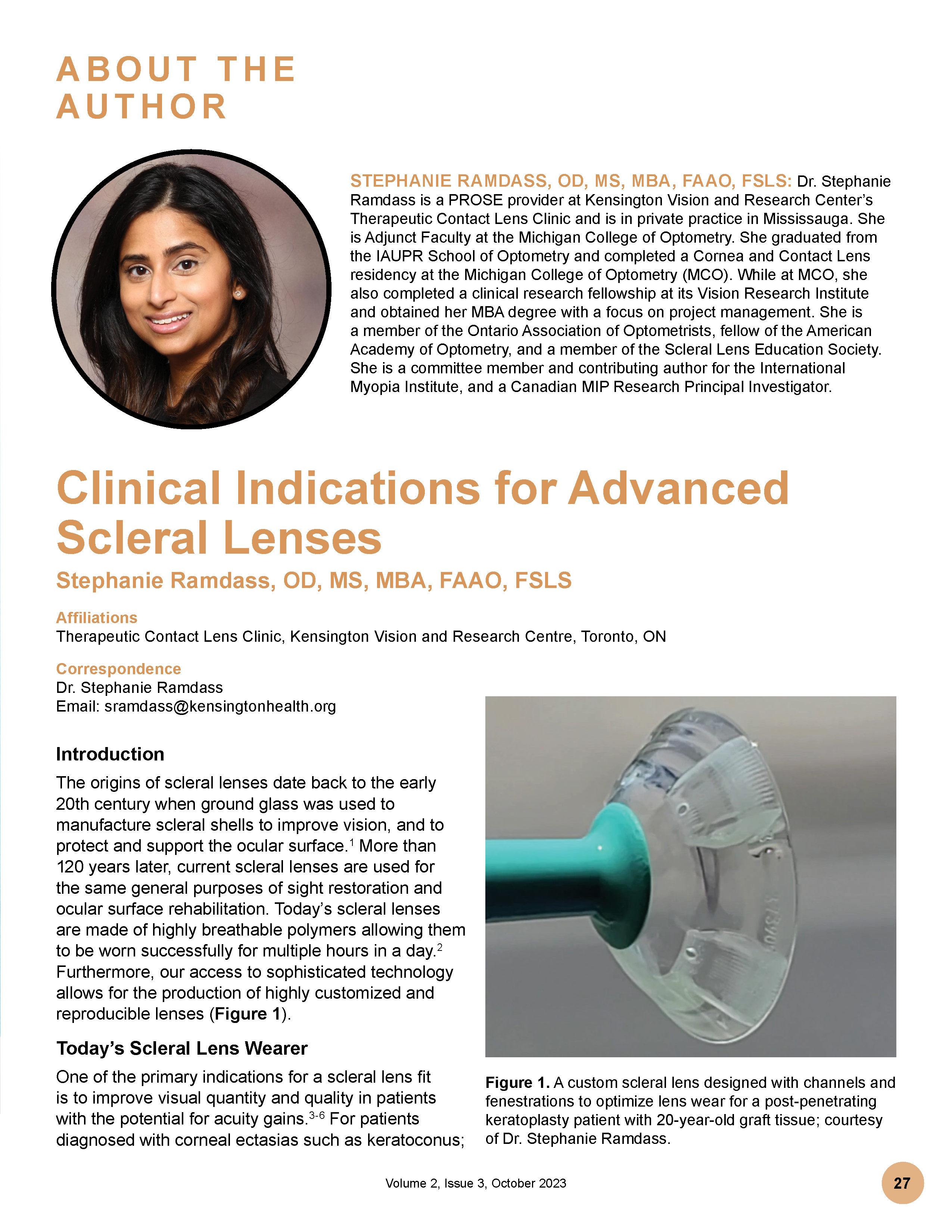Clinical Indications for Advanced Scleral Lenses
Abstract
The origins of scleral lenses date back to the early 20th century when ground glass was used to manufacture scleral shells to improve vision, and to protect and support the ocular surface. More than 120 years later, current scleral lenses are used for the same general purposes of sight restoration and ocular surface rehabilitation. Today’s scleral lenses are made of highly breathable polymers allowing them to be worn successfully for multiple hours in a day. Furthermore, our access to sophisticated technology allows for the production of highly customized and reproducible lenses.
References
van der Worp E, Barnett M, Johns L. Scleral lenses: history & future. Cont Lens Anterior Eye. 2018 Jun;41(3):243-244.
Manning J. Making sense of scleral lens materials. Review of Cornea & Contact Lens. 2018 Nov: 24-27.
Wong BM, Trinh T, Garg A, Mimouni M, Ramdass S, Liao J, Chandrakumar M, Slomovic AR, Chan CC. Prosthetic Replacement of the Ocular Surface Ecosystem for Terrien Marginal Degeneration: A Case Series. Eye Contact Lens. 2022;48:471-478.
Wong BM, Garg A, Trinh T, Mimouni M, Ramdass S, Liao J, Chandrakumar M, Chan CC, Slomovic AR. Diagnoses and Outcomes of Prosthetic Replacement of the Ocular Surface Ecosystem Treatment-A Canadian Experience. Eye Contact Lens. 2021;47:394-400.
Kawulok E, Schornack M, Nau CB, et al. Multicenter review of indications for scleral lens wear. Invest Ophthalmol Vis Sci. 2021;62(8):676.
Nau CB, Harthan JS, Shorter ES, et al. Trends in scleral lens fitting practices: 2020 scleral lenses in current ophthalmic practice evaluation survey. Eye Contact Lens. 2023 Feb 1;49(2):51-55.
Baudin, F, Chemaly A, Arnould L, et al. Quality-of-life improvement after scleral lens fitting in patients with keratoconus. Eye & Contact Lens. 2021 Sept;47(9):520-525.
Bhattacharya P, Mahadevan R. Quality of life and handling experience with the PROSE device: an Indian scenario. Clin Exp Optom. 2017;100:710-717.
Marty AS, Jurkiewicz T, Mouchel R, et al. Benefits of scleral lens in the management of irregular corneas and dry eye syndrome after refractive surgery. Eye & Contact Lens. 2022 Aug;48(8):318-321.
Wang Y, Rao R, Jacobs DS, et al. Prosthetic replacement of the ocular surface ecosystem treatment for ocular surface disease in pediatric patients with Stevens-Johnson syndrome. Am J Ophthalmol. 2019 May;201:1-8.
Heur M, Bach D, Theophanous C, et al. Prosthetic replacement of the ocular surface ecosystem scleral lens therapy for patients with ocular symptoms of chronic Stevens-Johnson syndrome. Am J Ophthalmol. 2014 Jul;158(1):49-54.
DeLoss KS, Le HG, Gire A, et al. PROSE treatment for ocular chronic graft-versus-host disease as a clinical network expands. Eye Contact Lens. 2016 Jul;42(4):262-266.
Garg A, Trinh T, Wong BM, Mimouni M, Ramdass S, Liao J, Chandrakumar M, Slomovic AR, Chan CC. Prosthetic Replacement of the Ocular Surface Ecosystem for Limbal Stem Cell Deficiency: A Case Series. Eye Contact Lens. 2022;48:493-496.
Liao J, Asghari B, Carrasquillo KG. Regression of corneal opacity and neovascularization in Stevens-Johnson syndrome and toxic epidermal necrolysis with the use of prosthetic replacement of the ocular surface ecosystem (PROSE) treatment. Am J Ophthalmol Case Rep. 2022 Apr 14;26:101520.
Vincent SJ, Alonso-Caneiro D, Collins MJ. Optical coherence tomography and scleral contact lenses: clinical and research applications. Clin Exp Optom. 2019;102: 224-241.
Mabaso RG, Sithole HL. Scleral topography and its usefulness in scleral lens fitting. Afr Vision Eye Health. 2021;80(1):a622.
Nguyen MTB, Thakrar V, Chan CC. EyePrintPRO therapeutic scleral contact lens: indications and outcomes. Can J Ophthalmol. 2018;53:66-70.
Nguyen LC, Kauffman MJ, Hastings GD, et al. Case Report: What are we doing for our “20/20 unhappy” scleral lens patients? Optom Vis Sci. 2020 Sep;97(9):826-830.
Yoon G, Johns L, Tomashevskaya O, et al. Visual benefit of correcting higher order aberrations in keratoconus with customized scleral lens. Invest Ophthalmol Vis Sci. 2010;51(13):3432.
Hastings G, Applegate R, Nguyen L, et al. Comparison of wavefront-guided and best conventional scleral lenses after habituation in eyes with cornea ectasia. Optom Vis Sci. 2019 Apr;96:238-247.
Harthan JS, Shorter E. Therapeutic uses of scleral contact lenses for ocular surface disease: patient selection and special considerations. Clin Optom (Auckl). 2018 Jul 11;10:65-74.
Barnett M, Lien V, Li JY, et al. Use of scleral lenses and miniscleral lenses after penetrating keratoplasty. Eye Contact Lens. 2016 May;42(3):185-189.
Isozaki VL, Chiu GB. Transient corneal epithelial bullae associated with large diameter scleral lens wear: A case series. Cont Lens Anterior Eye. 2018 Oct;41(5):463-468.
Fadel D, Ezekiel DF. Fenestrated scleral lenses: back to the origins? Review of their benefits and fitting techniques. Optom Vis Sci. 2020 Sep;97(9):807-820.
Aziza Y, Harada K, Ueta M, et al. Challenges in the management of bilateral eyelid closure in Stevens-Johnson Syndrome. Am J Ophthalmol Case Rep. 2022 Mar 5;26:101473.
Walker MK, Schornack MM, Vincent SJ. Anatomical and physiological considerations in scleral lens wear: Eyelids and tear film. Cont Lens Anterior Eye. 2021 Oct;44(5):101407.

Downloads
Published
How to Cite
Issue
Section
License
Copyright (c) 2023 Canadian Eye Care Today

This work is licensed under a Creative Commons Attribution-NonCommercial-NoDerivatives 4.0 International License.
